Scientific and academic publishing is broken. The vast majority of the
journals have been privatized by publishers who charge astronomical fees for
access to the literature.
The fees have gotten so high that even well funded universities have
started to walk away from negotiations. Universities with less funding have long been
unable to afford them. The average citizen has no hope of affording them.
With the results of the scientific process locked away behind paywalls, science
is no longer an open and transparent process. Worse, the ultimate deciders of
policy in a democracy, average citizens, are being denied access to the primary
source materials necessary to make good policy decisions.
The Open Access movement has been trying to solve this problem, but it has
mostly stuck to the existing model of hiring editors to manually match
reviewers to papers, creating high overhead. To fund their operations, most
Open Access journals have flipped the business model from fee for access to fee
for publish. This has created a whole host of new problems, including the rise
of predatory journals that are willing to publish almost anything by anyone who
can pay.
The ultimate effect of pay-to-play is that the traditional peer review and
refereeing process has broken down. If a dishonest researcher gets rejected
from a reputable journal, they can take their paper to a pay-to-play journal
and have it published there. With over 10,000 academic journals, it’s
impossible for the lay public to track which journals are reputable and which
are not. As far as the public is concerned, a published paper is a valid
paper.
This is a proposal for a software platform that may help the academic community
solve these problems, and more.
Peer Review is a diamond open access (free to publish, free to access) academic
publishing platform with the potential to replace the entire journal system.

Peer Review allows scholars, scientists, academics, and researchers to self
organize their own peer review and refereeing, without needing journal editors
to manually mediate it. The platform allows review and refereeing to be
crowdsourced, using a reputation system tied to academic fields to determine
who should be able to offer review and to referee.
The platform splits pre-publish peer review from post-publish refereeing.
Pre-publish review then becomes completely about helping authors polish their
work and decide if their articles are ready to publish. Refereeing happens
post-publish, and in a way which is easily understandable to the lay reader,
helping the general public sort solid studies from shakey ones.
Peer Review is being developed open source. The hope is to form a non-profit
to develop it which would be governed by the community of academics who use the
platform in collaboration with the team of software professionals who build it
(a multi-stakeholder cooperative).
Since the platform crowdsources the work of review and refereeing, and because
it can potentially handle all academic and scientific fields on a single
platform, we could eliminate most of the overhead of academic publishing.
Meaning Peer Review could be initially funded with small donations from the
scholars using it. If the platform were to eventually replace the entire
journal system, it could be funded by the universities for a tiny fraction (1%
or less) of what they are paying for publishing now.
Peer Review is currently at the alpha stage of development, most of the core features
are functional in a proof of concept. They need testing and hardening, and a
number of functionality gaps need to be filled in. I hope to reach a closed
beta in the next few months. And an open beta several months after that. I’m
seeking academics to give feedback on the concept, help test the alpha, and
help us prioritize the roadmap for the closed and open
betas.
If Peer Review succeeds, there are any number of ways we could take it. It
could potentially solve the file drawer problem from the beginning, by simply
giving scholars a place to submit, get immediate feedback on, and publish file
drawered papers. We could explore building systems to help incentivize and
highlight replications - linking replications to the studies they are
replicating and giving replications a reputation bonus. We could build
systems to assist with data sharing and funding transparency. We could even
explore automating some of the grunt work of maintaining the academic
literature - such as generating automated literature reviews. And we could work
to make the academic literature more accessible and understandable to general
public.
How It Works - The Overview
Here’s how the platform works in detail. When you have a draft of a paper
you’re ready to get feedback on, you submit it to the platform. You give it a
title, add your co-authors, and tag it with up to five fields or disciplines
(eg. “biology”, “biochemistry”, “economics”, etc).
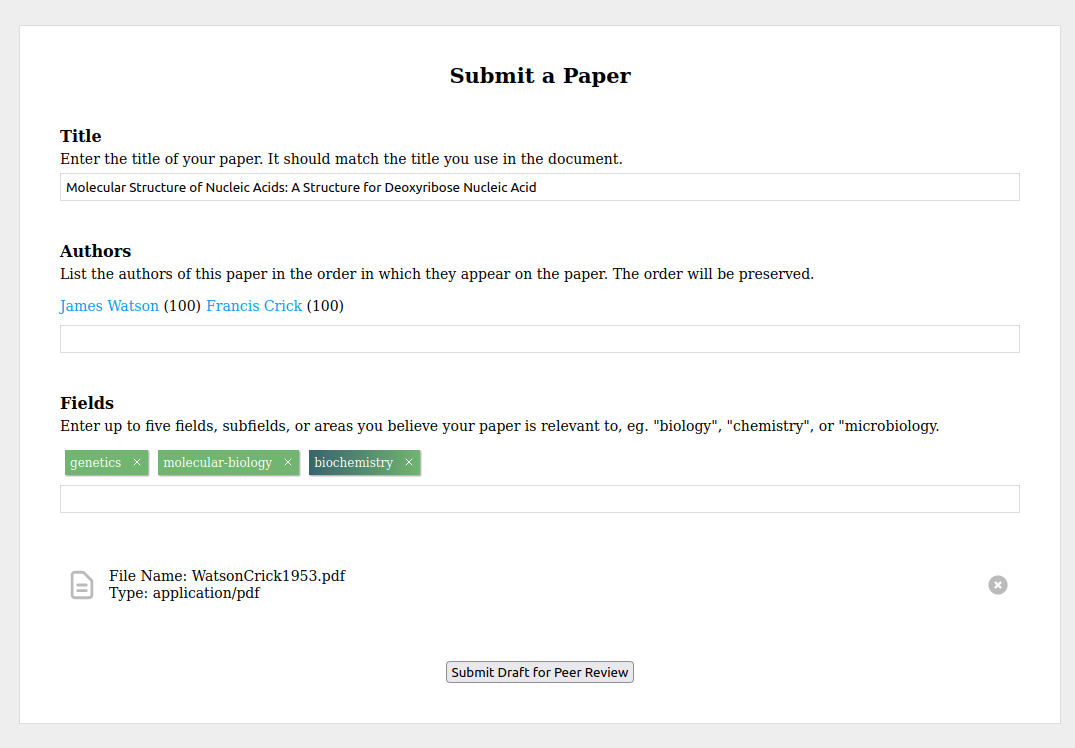
The fields exist in a hierarchical graph, which is intended to be evolutionary.
Each field may have multiple parents and many children - eg. “biochemistry”
which is a child of both “biology” and “chemistry”. The hierarchy can go as
deep as it needs to. We’re initializing the field hierarchy using Wikipedia’s
outlines of academic disciplines, but the intention is for the 1.0 version to
include the ability for scholars to propose new fields or edits to existing
fields, along with a proposed place in the hierarchy, and for their peers to
confirm the proposals.

When reputation is gained in a child field, it is also gained in all of that
field’s parents. So a paper tagged “astrophysics” also gives reputation in
“physics” and “space-science”. Reputation is primarily gained through
publishing and receiving positive feedback from your peers during post
publish-refereeing - more on that later.
When you hit submit, the draft goes into the review queue. Here other scholars who
have enough reputation in any of the fields you tagged the paper with can see
the draft and offer feedback on it.

This system gives scholars an enormous amount of control over who they solicit
feedback from. By choosing how high up the field tree they go, they choose how
wide to cast their net. Because they can add up to five fields (which don’t
have to be related) they can easily request interdisciplinary feedback.
Reviewers can click anywhere on the document to leave comments.
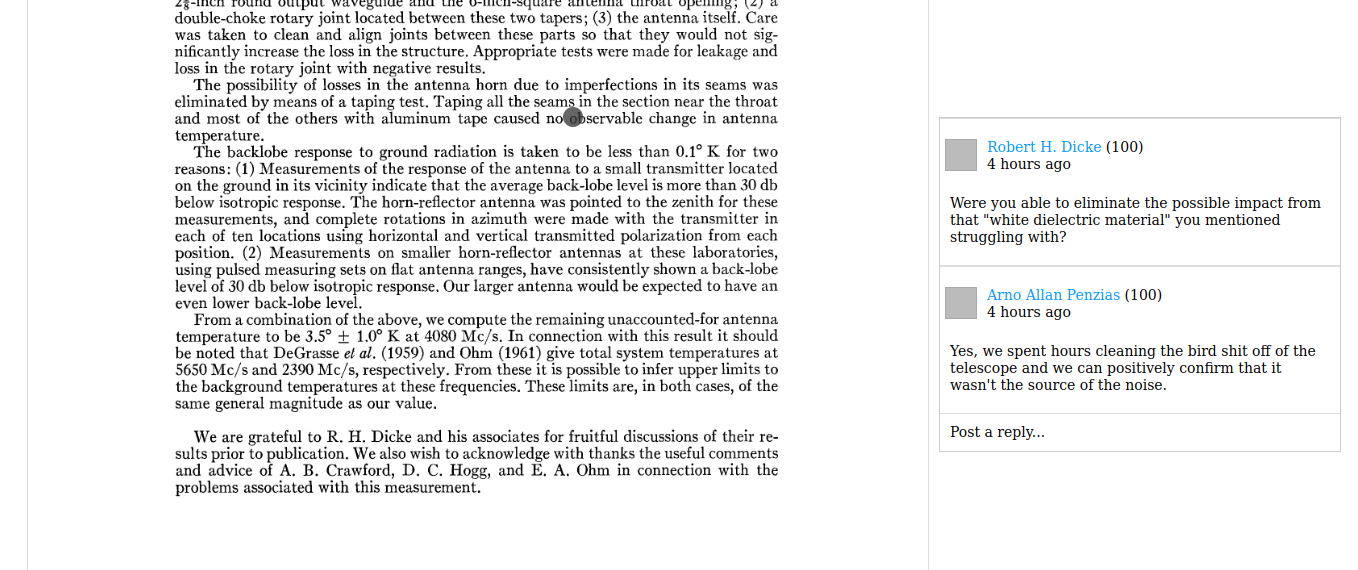
When they are ready, reviewers submit their review with a summary and a
recommendation. The possible recommendations are:
- “Recommend Approval” meaning that this draft is ready to publish.
- “Recommend Changes” meaning that they think it’ll be ready to publish after
the recommended changes are made.
- “Recommend Rejection” meaning that they don’t think this paper is worthy of
publishing, or could be made publishable.
- “Commentary” which is just a way to offer feedback and commentary with out a
specific recommendation.
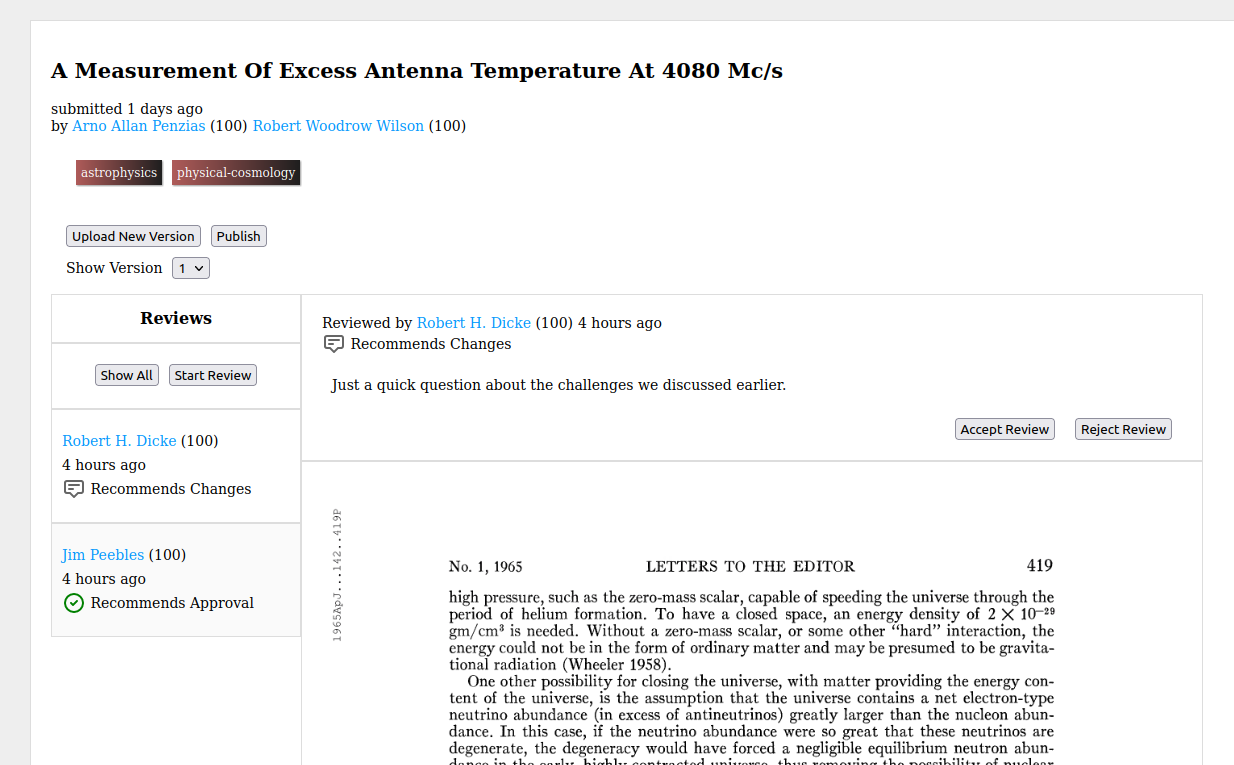
Authors can then mark reviews as “accepted”, indicating that they found them
helpful, or “rejected” indicating that they were not helpful. Reviews that are
“accepted” grant the reviewer reputation in the fields the paper is tagged with
(and their parents). Reviews that are “rejected” grant no reputation, but
don’t remove it either.
As the review process goes along, authors may upload additional versions of
their paper and request new rounds of review feedback for each version
uploaded. Reviewers may offer as many reviews to each version as needed, but
only gain reputation for a single accepted review on each version.
When the authors are ready, they hit “Publish” and their paper is published and
live to the world.
This puts the pre-publish review process entirely in the hands of the authors.
It gives reviewers an incentive to give solid, constructive review feedback -
and rewards good reviewers for their efforts with recognition of their
contributions. It treats review work as a valuable contribution to an academic
field alongside publishing.
Refereeing begins once the work is published.
At that point, peer scholars with enough reputation in the fields the paper is
tagged with can vote the paper up or down. Up votes increase the paper’s score
and grant the authors reputation in the tagged fields. Down votes decrease the
paper’s score and the author’s reputation in the tagged fields.
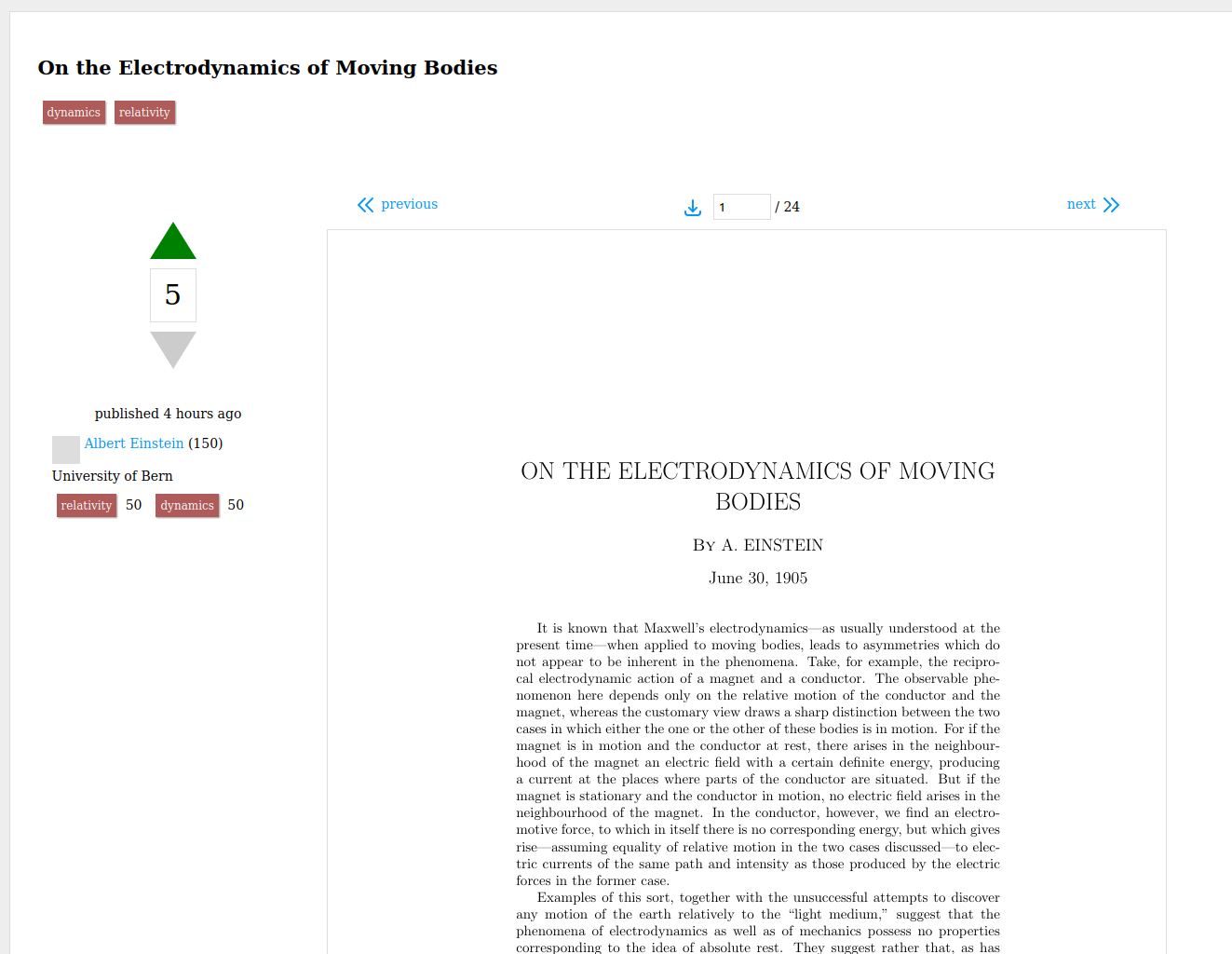
Up votes should be given based on an objective assessment of the paper’s
quality. Is this good science? A well constructed argument? Much of the same
criteria currently used to determine whether a paper should be published in a well
refereed journal, should be used to determine whether a paper should
be upvoted, downvoted, or simply left with no score. Instead of that judgment
being passed by a handful of reviewers selected by a journal’s editor, it will
be collected from the entire community of the fields the paper was submitted
in.
Peers can also post a single response to each paper, outlining their feedback
and reasons for voting how they did (or not voting at all) in public. Down
voters will be strongly encouraged to post a response explaining their
downvote.
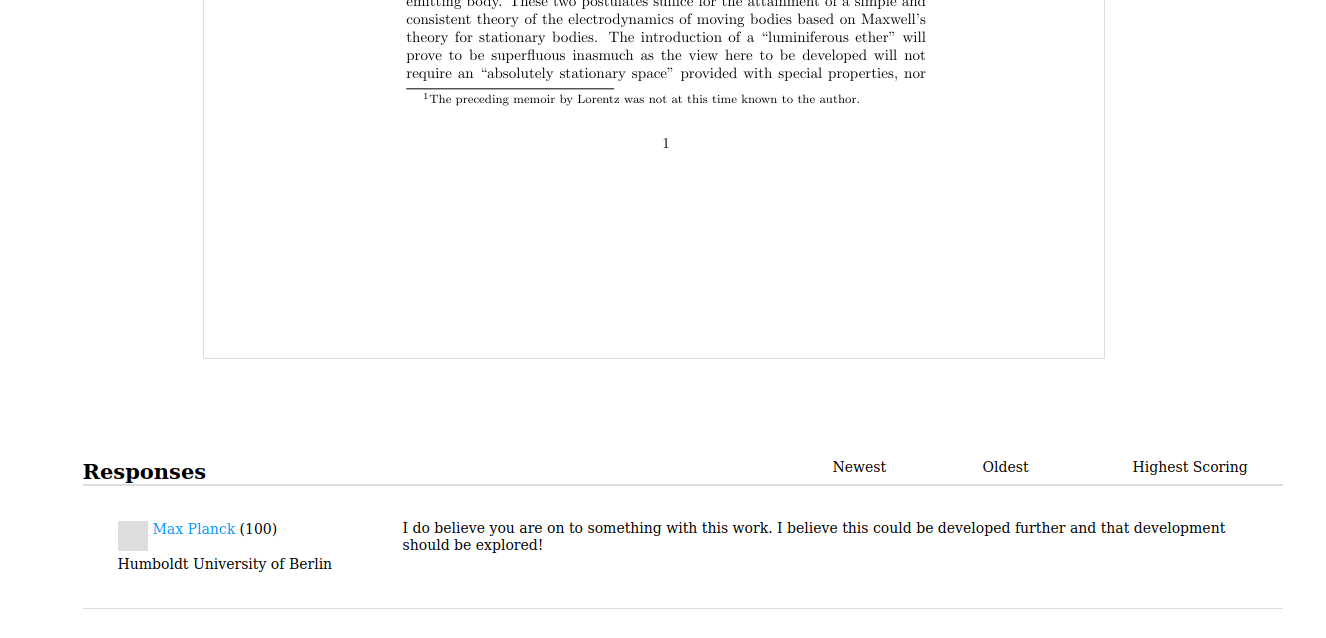
In this way, the refereeing process is made transparent and easy for the public
to follow. A down voted paper should be treated with skepticism. An up voted
one is trustworthy. The responses help add context and clarity.
All papers submitted to Peer Review are published under the Creative Commons
Attribution License, meaning the work
can be freely distributed, remixed, and reused as long as the authors of the
original work are attributed.
It’s important to emphasize: Peer Review is intended to be the final publish
step. It is not a pre-print server. It is an attempt to replace the journal
system with something open to its core, scholar lead, and collectively managed
by the scholar community.
Who Are You?
My name is Daniel Bingham and I’m the developer of Peer Review. I grew up in
an academic family (my mother and father are both professors and my brother got
his PhD), but went into software engineering. I taught myself to code at age 12
and have been in professional software development for well over a
decade.
My most recent role was Director of DevOps at Ceros, a
mid-sized software company. I built and lead the department which developed and
maintained the cloud infrastructure and deployment pipelines for the Ceros
Studio and
MarkUp. Before building the DevOps team, I was a full
stack developer at Ceros helping to build the Ceros Studio.
When I’m not writing code, I’m very involved in local policy. I’ve worked
closely with representatives of Bloomington, Indiana’s municipal government on
climate, transportation, and housing policy. I’ve served on government task
forces and on the boards of local non-profits, including a three year term as
president of the board of our local 501(c)3 affordable housing cooperative.
I’ve been dreaming about Peer Review for years. In my role as a policy
advocate, I needed access to the research literature, but struggled to get it.
As I pondered potential solutions to the problem of open access, the tools I
used on a daily basis as a software engineer inspired the concept that became
Peer Review.
I have a deep commitment to democracy, and I am as excited about the potential
to build a scholar and worker governed organization around the platform as I am
to build the platform.
Where Do Things Stand and Where Are They Going?
I am currently the only developer working on Peer Review full time. There are
a small handful of volunteers who’ve offered part time help.
I have the alpha version of Peer Review up on a staging server. I’m looking
for scientists, researchers, scholars, and academics from all disciplines who
are interested in exploring the alpha and giving me feedback on the concept and
where to go next.
Could this work the way I think it might? Are there things I’m not thinking
of? Problems I haven’t foreseen? Aspects of the academic publishing system I
am unaware of and that Peer Review doesn’t account for? Broadly speaking, am I
going in the right direction?
I have a roadmap of features I need to put in place before we can begin a
closed beta, and a significant amount of hardening and bug fixing to do as
well. I hope to reach a closed beta in the next couple months. I’m also
soliciting sign
ups
for the closed beta. Peer Review will only be as good as the community that
forms around it, so - if the direction I’m exploring does indeed hold promise -
I’m hoping we can start building that community now.
After the closed beta period I intend to do an open beta, where the platform is
opened to any who would like to use it (while still understanding that it is
not completely finished or polished).
You can view the roadmap on
GitHub. If you’re
unfamiliar with the process of software development, please keep in mind that
the roadmap is a very rough estimate and that it is constantly in flux.
I’m also looking for feedback on that roadmap, are there features which aren’t
currently included that should be considered for the closed beta? For the open
beta?
If you’re interested in exploring the alpha and giving feedback, want to
participate in the closed beta, or want to be notified when we reach open beta,
please fill out this
form!
You can also use that form to give feedback on the initial concept with out
signing up for anything.
If you think I’m on to something and you want to see Peer Review grow, please
consider supporting the development effort! Right now my family (my wife, my
daughter, and I) are living on savings. I’m hoping to raise enough through
donations to be able to commit to working on it full time, indefinitely.
I need to raise $8000 / month to make that commitment: $5500 of monthly living
expenses, $1500 to cover health care, and $1000 to cover the initial cloud
infrastructure costs for site hosting.
You can support me on GitHub
Sponsors. You’ll need to make a
GitHub Account, but it’s free.
If we successfully raise that much, I will form the non-profit. If we raise
substantially more than that I will hire additional engineers, designers,
product managers, devops, and QE to help with development. I will also be
pursuing grant funding once we reach the closed beta period. Any leads in that
direction would be much appreciated.
If you have questions, ideas, suggestions, criticisms, feedback of any kind,
grant leads, or offers of help that don’t fit into the form linked above, you
can contact me at contact@peer-review.io












